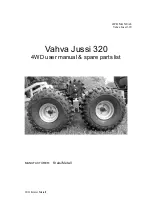
2
SeaStar Manual Jackplate
1.
Rinse off Jackplate(s) thoroughly using fresh, clean water only.
- Cleaning fluids containing ammonia, acids or any other corrosive
ingredients MUST NOT be used for cleaning any part of the
Jackplate(s).
1.4 During Use
1.5 After Use
To reduce risk of severe injury or death, always wear a Coast Guard
Approved personal flotation device (PFD) and use an engine shut-
off cord (lanyard).
Damage to outboard will occur if proper water pressure is not
maintained while the boat is under way. Raising the outboard too
high will result in a water pressure drop and overheating of your
outboard engine will occur. Proper water pressure must be
maintained at all times during operation of the outboard.
DO NOT attempt to steer with the engine at full tilt. Damage to
the Jackplate(s) and/or steering components could occur.
CAUTION
CAUTION
1.3 Prior to Every Use
1.
Inspect the Jackplate(s) for damage, cracks, deformation, wear
and binding. Check for loose mounting bolts and/or nuts.
2.
Confirm that there is no interference between the SeaStar
Jackplate(s) and the steering cylinder(s), tiebars, steering hoses,
outboard engine, outboard engine hoses or any combination of
these parts by performing the CLEARANCE CHECKS as detailed
in Section 2.5.
DO NOT OPERATE BOAT IF ANY COMPONENT IS NOT IN PROPER
WORKING CONDITION.
1.6 Maintenance
After
FIRST
use and every 100 hours or 6 months thereafter
(whichever comes first).
1.
Ensure the transom bolts and engine bolts are torqued to their
recommended values.
2.
Inspect the Jackplate(s) for damage, cracks, wear and binding.
Inspect the Jackplate brackets, adjustment screw and sliding
mechanism.
DO NOT OPERATE BOAT IF ANY COMPONENT IS NOT IN PROPER
WORKING CONDITION.
Any work being performed with this system MUST be completed
by a qualified mechanic with a working knowledge of the system.
WARNING


































